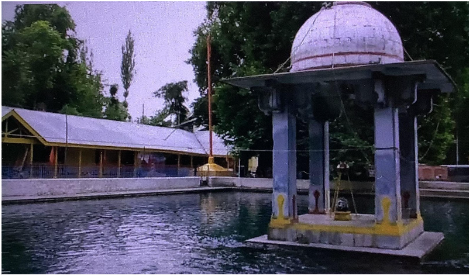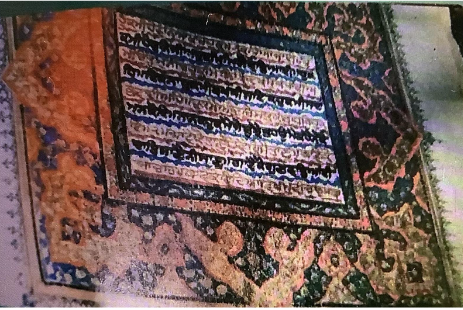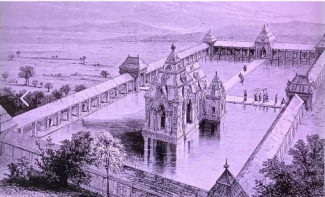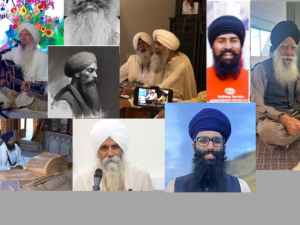The founder of the Sikh religion, Guru Nanak Dev Ji (1469-1539), was one of the most traveled great personalities during his lifetime. The Guru profoundly influenced people through his Bani by traveling thousands of miles on foot in four directions.
(Gurdwara Nanaksar Mattan,Kashmir, Photo by author). Guru Nanak Dev Ji traveled not only across India but also to different countries to spread the message of co-existential humanity for the existence of all humankind. Guru Nanak Ji completed four Udasis in 24 years (1497-1521 AD). In his third Udasi, he traveled through mountains to Sumer Parbat from 1515 to 1517.
A detailed account of Guru Ji's meeting with Pandit Brahmdas of Bijbehara is well-documented. After traveling to Leh-Ladakh, Guru Ji reached Amarnath, Pahalgam, and Ashu Mukam, where a shepherd gave goat's milk to Guru Ji and his companions. From there, Guru Ji sat near the Sukhdevi hill at Mattan, where he met Pali Hasna, a Muslim shepherd, who called Guru Ji a dacoit. When the shepherd went near his flock, he found the entire flock unconscious on the ground. He came back to Guru Ji, apologized, and said that all his animals were dead. Guru Ji told him to recite 'Waheguru,' and all his animals began to graze. After descending from the mountain, Guru Ji reached Mach Bhawan (Mattan), the old name of Mattan.
A cyclist named Bhai Dhana Singh wrote in his diary in 1932, "In this water canal, Sri Guru Nanak Dev Ji sat on a rock, and the Pandits who lived there came to discuss with Guru Ji. In a nearby cave, a few Saints were meditating, and they also joined the discussion. Guru Ji preached to them the way of truth and showed them a way to attain the Sacred and took a sacred bath in a water stream known as 'Bhawan Kund.' Nowadays, there is a small permanent Sarovar in this place, popularly known as Bhawan Kund. Fish abound in that stream, and when Guru Ji was bathing in it, a fish touched Guru Ji's feet and transformed into a human being, joining the discussion. Witnessing this miracle, all the Pandits became Guru Ji's followers. When Shiha and Hansu Lohar asked Guru Ji about the miracle, the fish, which had transformed into a man, began telling its story."
The chief of Mattan Nagar was Pandit Munkda, whom Guru Ji suggested to build a 'Dharamshala' at that place and meditate on Nam and start 'Langar.' Guru Ji stayed at Mattan Sahib for many days. Here Pandit Munkda built a small 'Dharamshala,' which, during the times of Muslim rule, was destroyed, leaving only the 'Thara Sahib.' In Mattan Sahib Gurdwara Nanaksar is the first Dharamshala established by the blessings of Guru Nanak Dev Ji in Kashmir Valley. Historians have dated the foundation of the 'Martand' around 370 to 580 A.D. Brahmdas Pandit and Kamaal Fakir came and met Guru Ji at this place. There was a Faqir named Juma Chopa who lived in the area of Mattan. He was in search of Ishq Hakiki but was unable to find Ilahi Wasle. When he came to know that a Faqir from Punjab had come to stay on the banks of the Twin Springs of Mattan, whose divine love had made even animals happy and filled the shepherds with illumination, he went to meet Guru Nanak Ji with utmost respect. The thoughts of Guru Sahib enlightened his heart and mind with the light of the Sacred. Kamal was, in reality, truly in quest of Ishq Hakiki, and he finally attained it, becoming a beloved disciple of Guru Sahib.
( A folio of Sunehri Bir of Guru Granth Sahib at Mattan Sahib). A Pandit named Brahamdas of Bejbehara was egoistic about his knowledge. Being a great scholar, he used to carry books on his two camels. Therefore, Brahmdas Pandit felt it beneath his status to go and talk to Guru Nanak Sahib. Brahmdas possessed many supernatural powers as he was a disciple of Devi. After hearing praise for Guru Sahib from others and on the persuasion of Kamaal Faqir, Brahmdas went to meet Guru Nanak Sahib at Twin Springs (Mattan) where Guru Sahib was staying. Before meeting Guru Ji, he wanted to impress the Guru by showing miracles. It is said that Brahmdas had a carpet on which he flew in the sky. Many people sat around Guru Ji to listen to his views. When Brahmdas reached Matan de Chashme (Twin Springs) on his carpet, he could see all the people except Guru Nanak. When he asked people about where the 'Nanak' from Punjab was, they said that he was sitting in front of him. Due to Brahmdas's ego and pride, he could not see Guru Ji. The next day, when Brahmdas went to meet Guru Ji on foot instead of the carpet, he could see him and asked him, "Why were you invisible to me yesterday?" Guru Ji said that he could not see him as he was in pitch darkness yesterday. Brahmdas said that he came to meet Guru Ji in daylight, and the question of darkness does not arise. Guru Ji said that there is no bigger darkness than ego, and Guru Sahib said yesterday you were flying on the carpet and feeling proud of being a great person. Numerous insects and birds fly in the air, but they are not countable. After listening to Guru Ji, Brahmdas became ashamed of himself. Guru Sahib uttered this Shabad after breaking the ego and corrupt soul of Brahmdas Pandit:
"Dhud bin dhain pankh bin pankhee , Jal bin utbhuj kaam nahin,
Kya sultan salam veetuna , Andhi kothi tera naam nahin"
Guru Ji, upon seeing Pandit Braham Das coming with a huge stock of books, Sung the following couplet:
"Padh padh gaddi ladiye, padh padh bhariye saath
Padh padh beri payiae, padh padh sadiye khaat
Padiye jaite baras baras , padiye jaite maas
Padiye jeti aarja padiye jete saas , Nanak lekhe ek gal hor haumai jhakna jhak".
"One may read thousands of books, with cart load of books to follow,
One may study innumerable epics or fill, One's cellars with volume of study,
One may read for generations and generations.
And spend every month in the year studying
And one may read one's entire life, Right up to one's last breath,
Sayeth Nanak, there is one truth: His name only. All else is Vanity of the egoistic mind."
At Mattan Sahib Guru ji sung Malar di Var and was preserved by his companions. Brahmdas Pandit came to realize the uselessness of the weight of knowledge without practical wisdom, and he asked to be pardoned after falling in humility at the feet of Guru Sahib. Pandit Mukande, Pandit Brahamdas, Faqir Kamaal, etc., built a Dharamshala as ordained by Guru Ji at Mattan Sahib for preaching to all sections of society by establishing the Manji (seat) bearing the name of Guru Ji. After staying for many weeks at Mattan, Guru Ji reached near the spring of Nagpal. According to Mahankosh , an annual Jagir of Rs. 50/- was associated with this Gurdwara in early times. According to Giani Budh Singh "Guru Nanak reached Mattan Sahib (Gurdwara exists) sitting on the bank of the fountain, through his teachings, led many to the path of prayer. Behind Matan, they sat on a high hill. The famous testimony of a shepherd on that hill. Pandits have occupied this place and built a small temple here and placed the idols. The Gurdwara had a lot of jagir by Maharaja Ranjit Singh, knowing this Gurdwara of Guru Ji as a memorial place, now only ₹122 have been left." (Chonve Rattan, Lahore, 1937)
According to historian R K Parmu" Long ago Kashmir had been treated as a holy place by the great Gurus. The founder of Sikhism, Guru Nanak, had paid a visit to the Valley and the Gurdwara at Matan, Anantnag, commemorates the pilgrimage undertaken by him in the fifteenth century A.D. He made many converts after one of the leading Kashmiri Brahmins, Brahma Das, had accepted the Guru's faith." (A history of Sikh Rule in Kashmir 1819-1846, Srinagar,1977 ,P. 123). It is believed that Guru ji stayed thirteen days at Mattan. In the middle of the spring pond, a raised platform was seen on which Guru ji had a discussion with Kashmiri Pandit Brahm Das of Bej Behara, who was Proud of his Knowledge. Now-a-days the platform parts are seen in the bottom of the spring pond. Earlier there were no stone walls of Hindu temples around this pond. According to Editor 'Reformer' Lahore and Twarikh Kashmir (Pt. Hargopal Kaul Khasta), the stone wall and Garden was constructed by King Shah Jahan.
Later on S. Gurmukh Singh who was a member in the council of Afghan reign (Governor Kashmir Noor Din Khan Bambazi) constructed a splendous Gurdwara in 1766 AD. In 1821 AD Governor Hari Singh Nalwa, constructed seven small Gurdwaras on the three sides of the twin springs.
[Seven Gurdwaras in Mattan Sahib during Sikh Rule ( photo by J.Duguid 1870-73)]
In which seven Sri Guru Granth Sahibs were installed.Two volumes had been taken away by SGPC Amritsar, now five volumes are still inside the Gurdwara. Among them Sunehri Bir is still preserved in Gurdwara Sahib.Three villages were attached to the Gurdwara as its property; Paibhug, Mattan and Mace Gaam. The three villages later were annexed by the Dogra rulers . During the reign of Maharaja Partap Singh Dogra these Gurdwaras were removed
.On the ruined platform around the spring pond Maharaja Hari Singh Dogra constructed a temple in 1944 AD.
According to the Census Report of 1943 by R. C. Ratard
"There is evidence to show that there were Sikhs in the country (J & K) as early as the 16th century. The Gurdawara at Mattan commemorates his (Guru Nanak's) visit."
(Photo by S.Dhana Singh Cycle Traveler, Mattan,1934)
According to eyewitness Sewa Ram Singh District and Session Judge Rawalpindi “The romanants of a Platform in the center of the lower tank of the Twin Springs at Matten indicate the spot where the Master had sat, while some ruins of the pillars of the causeway leading up to the platform from the left side of the Spring are also visible. In 1908, when the present writer first visited Kashmir, he saw one of the seven Gurdwaras, which had been built on three sides of the twin Springs, still standing and he read a sermon from the Granth Sahib to the assembled audience in that Gurdwara, That Gurdwara, however, has also gone in ruins, and a new one seems to have recently been constructed, not on that after but along the south-western corner of the lower Spring. It is difficult to say who is responsible for this act of vandalism.” (The Divine Master, 1989, P 144)
According to Dr GMD Sufi
" The Gurdwara of Mattan, Baramulla and outside Kathi Darwaza, Srinagar were built by Nalwa (Kashir)
The Sikh Granthis of this place have been given Pattas of Gurdwara Nanaksar by Maharaja Ranjit Singh which were also taken away by Bhai Kanhiya Singh Baramulla on the instructions of Dogra rulers. During Sikh rule there were 84 rooms associated with these Gurdwaras. When Sikh historian Sewa Ram Singh first visited Mattan Sahib in 1908 AD. At this place, he saw only one Gurdwara. Now-a-days only one Gurdwara is seen on the right side of the spring, near Surya Mandir, although this Gurdwara is constructed later on, away from the spring. Deodar and kail wood is utilized in its construction. On the right side, near Surya Mandir, Kesri Nishan Sahib is hoisted, which is 35 feet high and 3 feet in circumference. Its basement is about 8 feet in square. A Khanda Chakra is also seen on its top. One of the copies of Guru Granth Sahib is about sixteen centuries old. Its first two pages are believed to be written with gold ink, by S. Hari Singh Nalwa.
On one side of the Gurdwara, a board is placed on which the following Urdu couplet is written as mentioned by Kashir Encyclopaedia . "Gurdwara Pehli Patshahi Nanaksar Matan Sahib Kashmir Yahan Guru Ji Brahm Das Pandit Se Gosht Ki.”
SELECT BIBLIOGRAPHY
1. Vir Singh, Bhai, ed., Puratan Janam Sakhi. Amritsar, 1982
2. Santokh Singh, Bhai, Sri Gur Pratap Suraj Granth.Amritsar, 1927-35
3. Gian Singh, Giani, Twärikh Guru Khälsä [Reprint). Patiala, 1970
4. Gian Singh, Giani. Tawarikh Guru Khalsa, Lahore, 1897.
5. Bhai Dhana Singh 'Gur Tirath Cycle Yatra' - (ed) Chetan Singh, Patiala.2016
6.Sarna, Jasbir Singh Jammu kashmir de Sikh Twarikh, Kashmir, 1997
7.Sarna JS, Bedi,DS Gurdwara Kosh, SGPC, Amritsar, 2013
8. Teng M U (Ed) Kashir Encyclopedia, (Kashmiri), 2nd Vol, Kashmir, 1989
9. Sarna J S. The Sikh Shrines in Jammu and Kashmir, Srinagar, 1994
10. Sarna J S. Jammu Kashmir de Itihask Gurdware, Chandigarh, 2005
11.Nabha, Kahn Singh Gurshabad Ratnakar Mahankosh, Delhi, Reprint 1990
12. Kohli, Surinder Singh Travels of Guru Nanak, Chandigarh, 1978
13. Fauja Singh, Kirpal SinghAtlas Travels of Guru Nanak, Patiala, 1976
14. Sufi, G M D. Kashir, 2 Vols,Srinagar,Lahore, 1948
15. Singh, Sewa Ram The Divine Master, 1904, Reprint 1989.
16. Teja Singh, Ganda Singh A Short History of the Sikhs, Patiala, Reprint 1994.
17. Budh Singh Giani Chonve Rattan, Lahore, 1937
18. Ahmad, Shamasdin, Dr, (Kashmiri Tr) Twärikh e Hassan {1303-1885 AD}, Srinagar, 1999.









